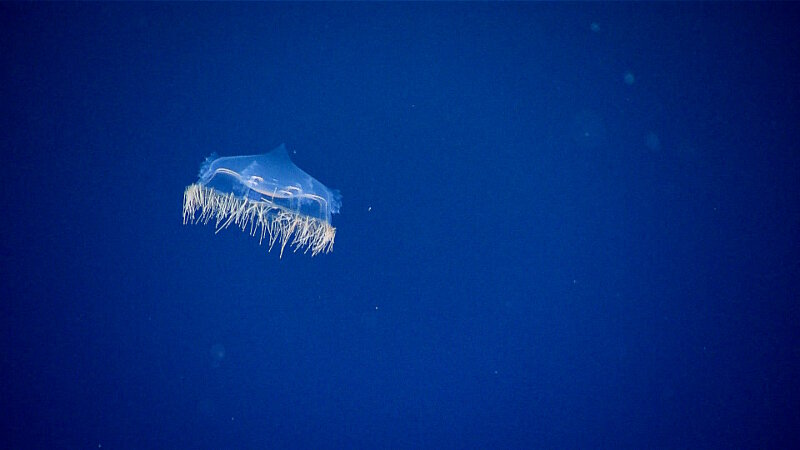What is an oxygen minimum zone?
Oxygen minimum zones are persistent layers in the water column that have low oxygen concentration due to biological, chemical, and physical processes. As oceans warm, oxygen minimum zones increase in number and size across the globe.

A hydromedusae jellyfish, seen here drifting in the water column, is one species that may be found in an oxygen minimum zone. Image courtesy of NOAA Ocean Exploration, Mountains in the Deep: Exploring the Central Pacific Basin. Download image (jpg, 1 MB).
While listening to a live remotely operated vehicle (ROV) dive, you may hear scientists mentioning oxygen minimum zones, or areas of low oxygen saturation in the ocean that occur naturally and persistently between 100 and 1,500 meters (328 and 4,920 feet) in depth. These zones are often sandwiched between two layers of higher oxygen concentration: the surface, where gases from the atmosphere mix with water, and the deep ocean, where extremely cold water that readily stores dissolved oxygen meets the ocean bottom. Heavy stratification, or separation into horizontal layers, and reduced mixing in these layers allows oxygen minimum zones to persist over large stretches of geological time.
While many organisms with high oxygen demands (such as tuna or swordfish) cannot survive for any length of time within oxygen minimum zones, others have adapted to maximize the amount of oxygen they are able to absorb from the water. These adaptations include increased gill surface area, efficient circulatory systems, and an abundance of proteins that bind readily to oxygen. Other creatures, like the gelatinous hydromedusae jellyfish pictured above, evolved to have a low-energy lifestyle that requires them to use very little oxygen. Where oxygen minimum zones meet the seafloor, large, microbial mats often form; the compounds generated from interactions between these microbes might have biopharmaceutical properties that could be important to science and medicine.
Although oxygen minimum zones naturally exist in the water column of the open ocean, deoxygenation, or the loss of oxygen, in the ocean is exacerbated by climate change. Oxygen dissolves easily in cold water; this is why the colder deep ocean has a higher oxygen content than the warmer water in the oxygen minimum zone. As heat from the atmosphere is transferred into the ocean, warming near-surface waters lose the ability to hold high concentrations of oxygen. Circulation between ocean layers is also reduced due to increased stratification from warming at the surface, which decreases the rate at which oxygen is replenished. The upper boundary of an oxygen minimum zone then becomes more shallow and threatens organisms that require higher concentrations of oxygen to survive.
Because oxygen is essential to most life forms, monitoring areas where there is little oxygen is important to understanding how environmental changes are impacting the ocean ecosystem. As the number and size of oxygen minimum zones increases in the open ocean, scientists will continue to collect data on how these changes may affect ocean habitats, organisms, and fisheries.
By Logan Kline, 2023 John A. Knauss Marine Policy and Science Communication Fellow, NOAA Ocean Exploration
Published April 18, 2023
Last updated August 21, 2024
Relevant Expedition: 2023 Shakedown + EXPRESS West Coast Exploration